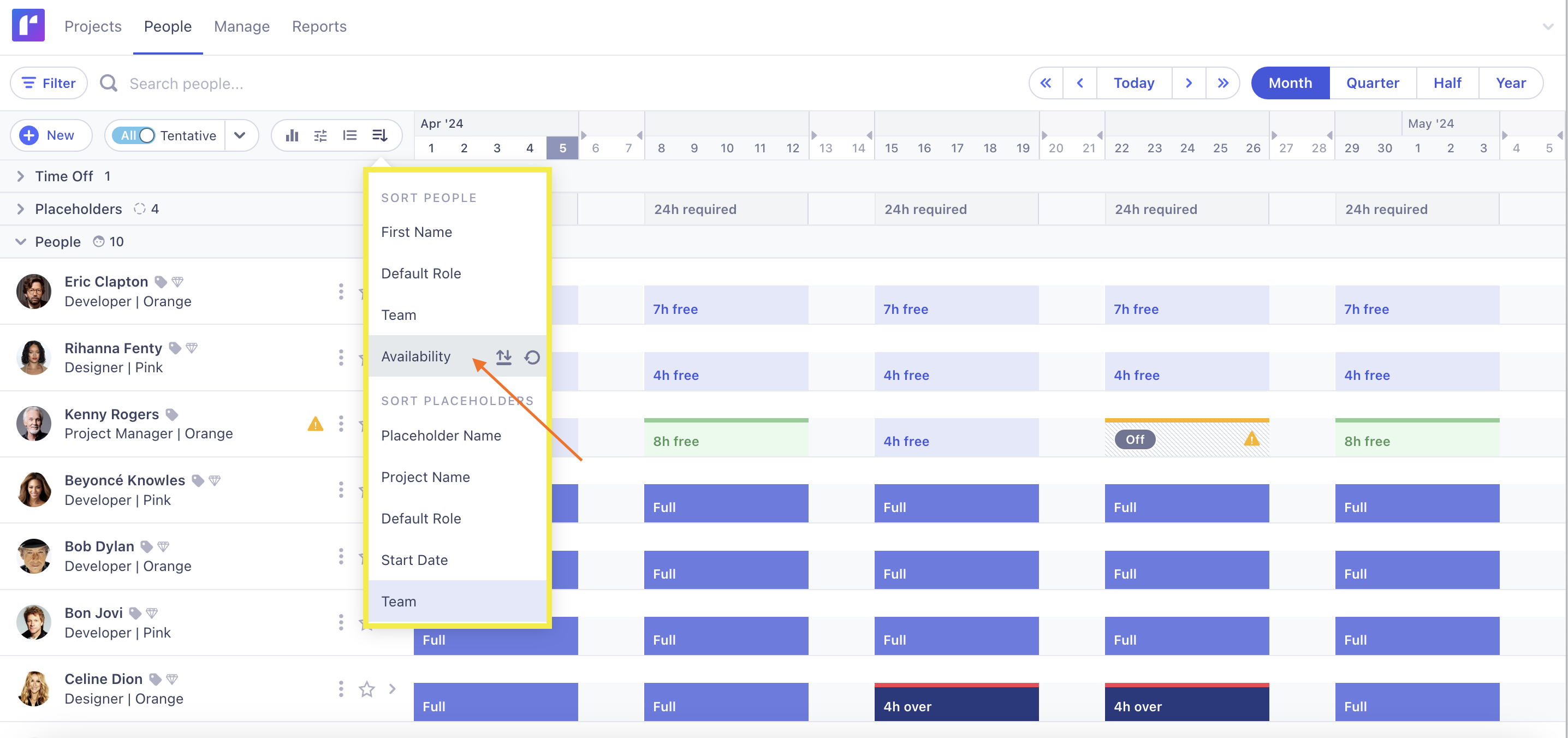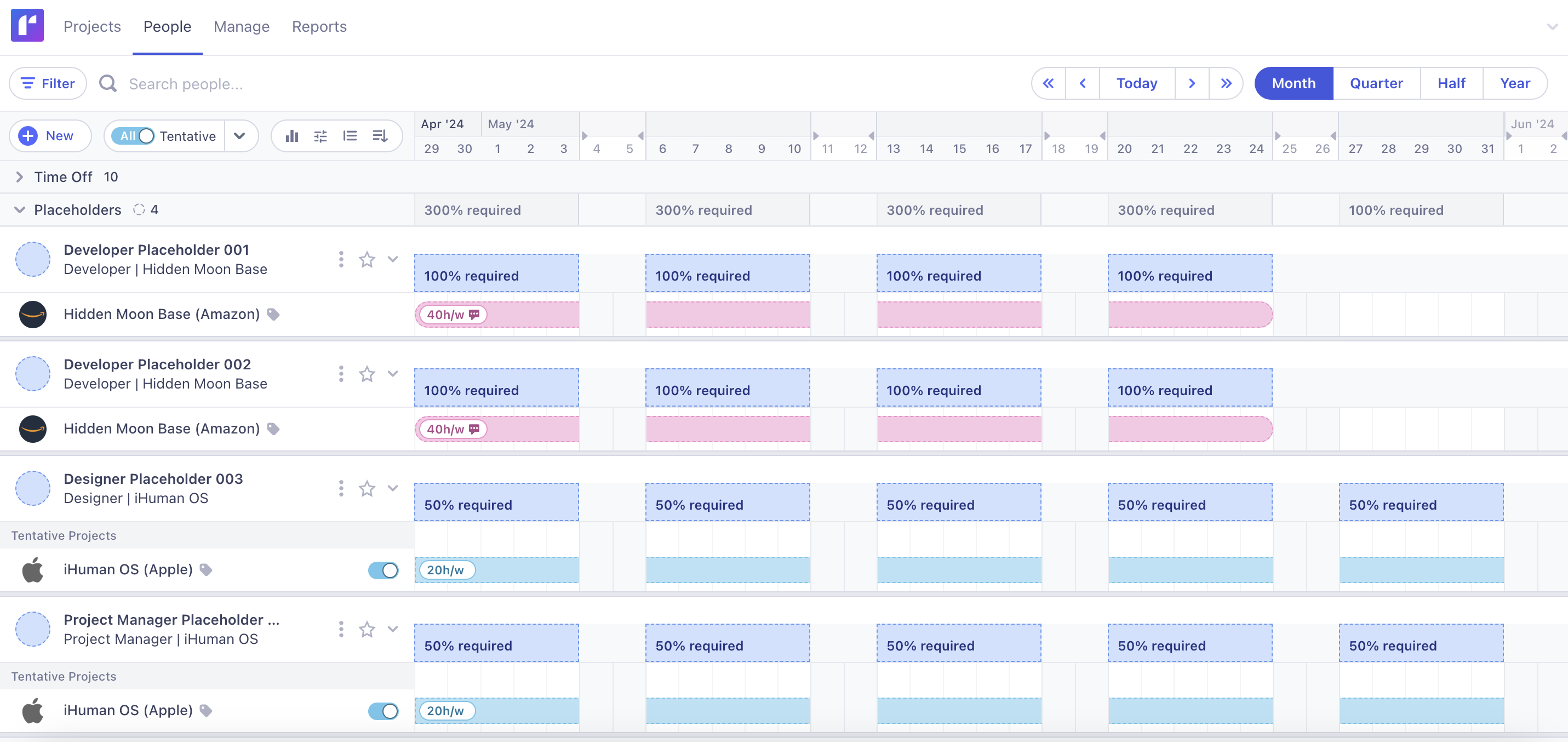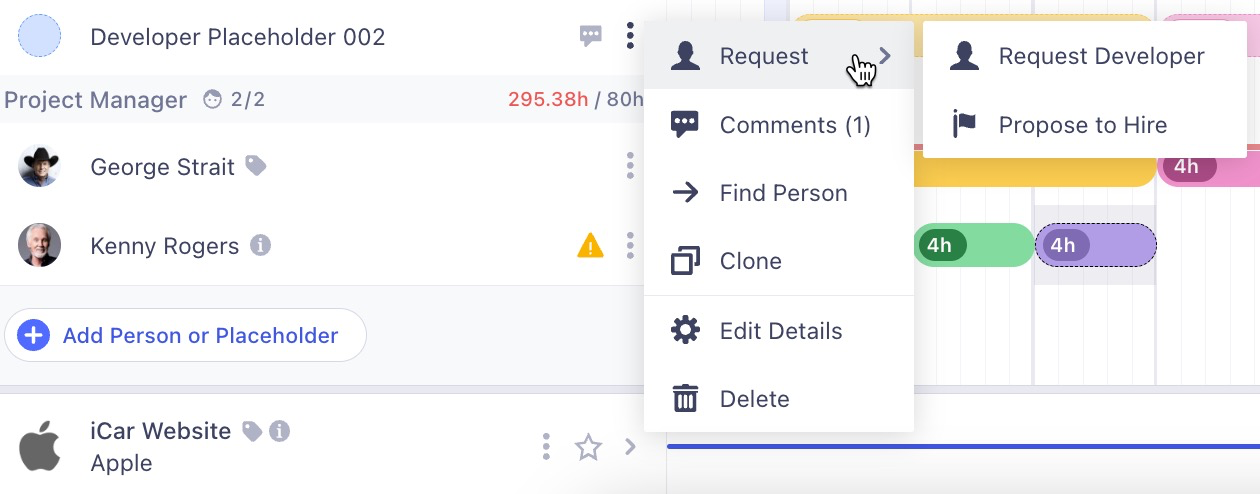Learn to develop resource plans that help deliver projects on time and on budget, save your business money, and speak to your team's strengths.

You’ve got lots of projects and people and want to plan everyone's time better?
It's time to enter resource planning.
When done right, resource planning can not only improve your project’s success rates but also boost employee engagement and help the business save money.
A holistic approach is all you need.
Resource planning is the process of identifying the right people to work on a project. It then involves distributing tasks to team members based on their capacity, skill sets, and best fit for the work.
Everyone and their mother defines resource planning as determining the right people to assign to the right projects at the right time. 😊
.png)
Sounds and looks simple but - in reality - there are more moving parts than meets the eye.
You need to accommodate many things in your resource plan, such as time off, seniority, cost, availability, skills, employee preferences, and the list goes on.
Add to that, resource planning is not just about numbers and schedules; it's about understanding the individuals behind the work, their strengths, and limitations, and ensuring their workloads are manageable, all while striving for project success.
💡In fact, at the stage of resource planning, resource or project managers get to test themselves on how well they know the people they're assigning to the project in question.
As former Baker Tilly's Director of Resource Management Christine Robinson pointed out in our webinar:
I'd say the first and the most integral and basic best practice as it relates to resource management is really drilling down to the fundamental, which is the resources that are being managed are people, and so establishing that relationship with the people that are very talented, that are being aligned in different ways, and really understanding how they are motivated and what they aspire to, that's going to be the key to success across the board.
Helping our customers do resource planning for years with our software, we could write a book on why resource planning is important and the ROI it can help organizations achieve. But to keep it short and simple, here are a few rock-solid reasons why it's essential to integrate resource planning into your project management process.
Developing a thorough resource plan before starting a project offers the following advantages:
➡️ Further reading: 5 Powerful Benefits of Resource Planning for Any Organization
In discussing the benefits of resource planning project management, it can help to see the issues that you avoid when you do it well.
.png)
When we talk resource planning with potential customers, the word we hear most often is ‘chaos’. They're trying to manage multiple projects that are constantly changing. And without the right tools, techniques and information, they always feel on the back foot.
As with most things in business - if you can't be proactive, you get stuck being reactive. And that's never the best approach.
There are a lot of problems that result from poor resource planning. Or that make effective resource planning really difficult.
But just because it’s difficult doesn’t mean you shouldn’t do it. In fact, it means it is even more important.
Because if you think things are crazy now, wait until your organization grows, or wins more projects, or opens another office. Then you’ll really know what chaos feels like! Here are the challenges you and your organization could be facing right now.
Transparency is essential for effective resource management. You need to know who's available, what their skills are, if they're earmarked for other projects, whether they're operating at capacity or have bandwidth for more work. Without this information at your fingertips, your project plans are a shot in the dark. This can mean last minute changes to your best laid plans. And that undermines your ability to deliver desired project outcomes.
Resource planning is about assigning the RIGHT people to the RIGHT project at the RIGHT time. Without resource planning processes in place, you can't always do that. The risk is that you'll assign people with sub-optimal skills who aren't up to the task. Or the opposite - assign overqualified resources who cost more than you need to spend. Either way, your budget and project's success is at risk.
This challenge is about resources not being used to their full potential. For example, working on low value projects or involved in busy work that could be assigned to someone else. This means you're not getting the best out of the people you pay so handsomely for. It's like buying a Rolex to use as a paperweight. Not the best use of what you've got!
➡️ Related: Agency Resource Management 101
Ad hoc allocation is when there's no strategy behind how you allocate resources. You allocate at random with no analysis of skills need, incoming demands, project goals etc. If your agency simply operates on a first-come-first-served basis - whereby the first person to ask for resources, gets them - you could be undermining your project efficacy and profit margin. If there are multiple demands on your resource, you should be prioritizing your projects. This ensures optimal resource utilization - assigning your MVPs to projects that move the needle most for your business.
Your team don't spend 100% of their work day on projects. There's often a lot of admin - like meetings, emails - plus eating lunch and even going to the loo. So you need a way to work out exactly how much time they DO have for projects. Overestimating resource capacity can lead to slippage in your schedule. Or overworked resources trying to catch up and reaching burnout.
➡️ Related: The Importance of Billing Accuracy for Services Businesses
Some organizations do try to track and plan resource but aren't using the right tools. We hear horror stories about spreadsheets and Google Docs that make our eyes water. Endless scrolling. Manual calculations. Best-guess allocation. This reduces your effectiveness in other areas of your PM responsibilities. A proper resource management tool lets you visualize resources, see availability at a glance, and simply drag-and-drop resources to allocate them. This saves you time and makes it much easier to find the right people for your project.
This is related to the problem above. Sometimes your planning tools start out great. But as you grow, they grow unwieldy. More projects, more staff, more complexity. Otherwise-organized PMs find themselves in a constant state of reaction and unable to get ahead of their projects - thanks to formerly fit-for-purpose planning tools like spreadsheets. Using dedicated resource planning software makes life easier, so you can do what you need and get back to other work.
➡️ Related: Runn vs Spreadsheets - Which is Best for Resource Management?
The challenge of not being able to predict when to hire of fire is all too common. Without adequate resource and capacity planning, your agency might overestimate how much work they can handle. To keep up, they might need to make some last-minute hires. This is never ideal as you often pay over the odds to go through a recruitment agency and need to rush the onboarding process. Capacity and resource planning tools give managers better insight into capacity and recruitment needs, so they can be properly planned and managed.
➡️ Further reading: Staffing Smart - How to Identify Hiring Needs
Finally, let's not forget that 'resources' are people. They need to be handled with care and respect or they can get disenchanted and leave. Losing staff is a risk in any business because replacing, onboarding and training staff takes time and money. But talent turnover is a particularly big risk in professional service firms, where you can lose a client if they lose their key contact. Resource planning software can help you manage resources better - keeping team members at the right level of challenge, stimulation and satisfaction. And, most importantly, avoiding burnout - one of the leading causes of talent turnover.
If you face one of the challenges above, it's time to revisit your resource planning approach.
➡️ Related: The Difference Between Reactive & Proactive Resourcing
If you're sold on the idea of resource planning, you're probably wondering where to start. Here are seven steps to get you going.
In order to plan effectively, you must have good knowledge of all the resources that are required within the project from the very beginning. Drawing from project requirements, you can get a good idea of all the resources and skills the project needs, and when they should step in. This will inform your company's hiring decisions and a resource plan respectively. Mind that it’s important to be thorough in assessing what you need in order to be efficient.
➡️ Related: 8 Best Practices for Requirements Gathering in Project Management
The availability of resources is a critical aspect of project resource planning and management. It relates to the knowledge you have about what resources you can utilize, when, and under what conditions. Knowing your resource availability requires looking at each employee's allocations now, as well as days, weeks, and months ahead of time, to figure out the gaps when their time is not occupied.

If resources are available, you are allowed to use their time for the duration of your project. As a result, a typical resource availability matrix will include everyone's workload, as well as vacations and personal time off.
Sometimes that may be straightforward, but other times it may require more in depth planning.
For example, your resource may be pre-booked to doing something that is within a higher priority area of the business. Think if it's possible to adjust your schedule of work to focus on other aspects of your project in order to utilize your current resources while you wait.
It’s expected that for some assignments you won’t be able to find resources with the right capabilities. This happens all the time, and for that case, Runn has a feature you could use to create an allocation without adding the resource.

When you know you’ll need a certain type of resource but not the exact people you want to allocate, you can add placeholder resources - Graphic Designer, Project Manager. This lets you plan the project and estimate resource requirements and costs, even if you don’t have specific people in mind yet. It also helps flag resource constraints and recruitment needs in advance.
Further reading: What is a Resource Request Workflow & How to Improve it
Once you know what skills and capabilities you're missing based on the placeholders you created, it's recommended to start making a case for bringing in new roles or upskilling people that sit on the bench.

At its most basic level, a resource management plan is a standard resource management technique that ensures your project has the resourcing it requires.
Your plan includes identifying the resourcing that a specific task requires, acquiring that resource, and re-allocating it once it’s no longer required. Here are the key elements of a resource management plan to set yourself up for success.
Without a plan, you may get to a stage of a project and realize you don’t have a resource you need, or it may be used elsewhere.

Managing your team is all about how you ensure team members remain as productive as possible without putting them on overdrive. It’s essential to consider the following concepts:
A proactive approach into managing your teams is vital to promote their wellbeing at work and get the most out of your staff.
As we've hinted at above, resource planning is much easier with the right tools. If you're struggling to manage resources using spreadsheets, then you might benefit from dedicated software for resource planning.
Resource planning software helps solve those challenges we talked about earlier. It takes the guesswork out of forecasting and the manual effort out of planning and managing resources. Which means you can effectively manage multiple projects - and build a best-fit project team - every time.
Here's what some of our customers say about Runn capacity and resource planning software.
If you want to discover the benefits of Runn for yourself, sign up for a free trial today.